Jump into the wonderful world of the Monstera Deliciosa, a big, leafy plant that’s become a favourite in the UK. It’s known for its big green leaves that have unique holes, making it really stand out. It’s a bit like its family members, the Monstera Albo, Obliqua, and Adansonii, but the Deliciosa has its own special look.
This plant comes from the rainforests of Central America but has found a cosy spot in our homes. It’s not too tricky to look after, making it a great choice whether you’re new to plants or already have a few.
Appearance of Monstera Deliciosa
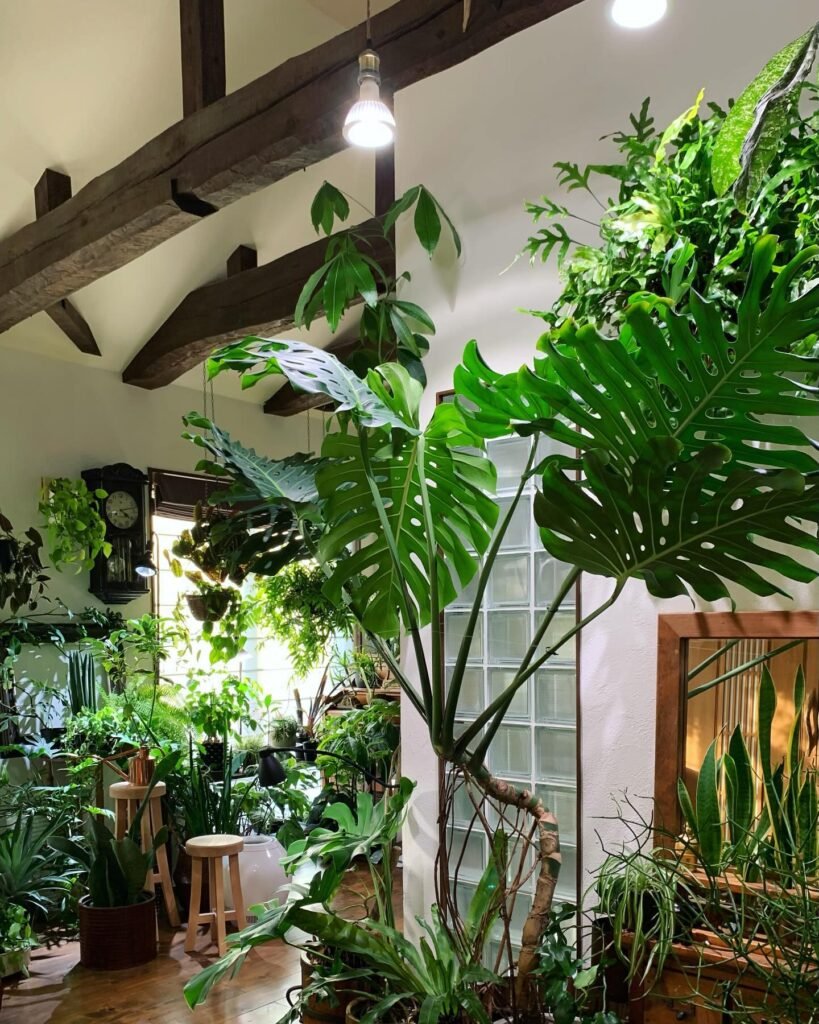
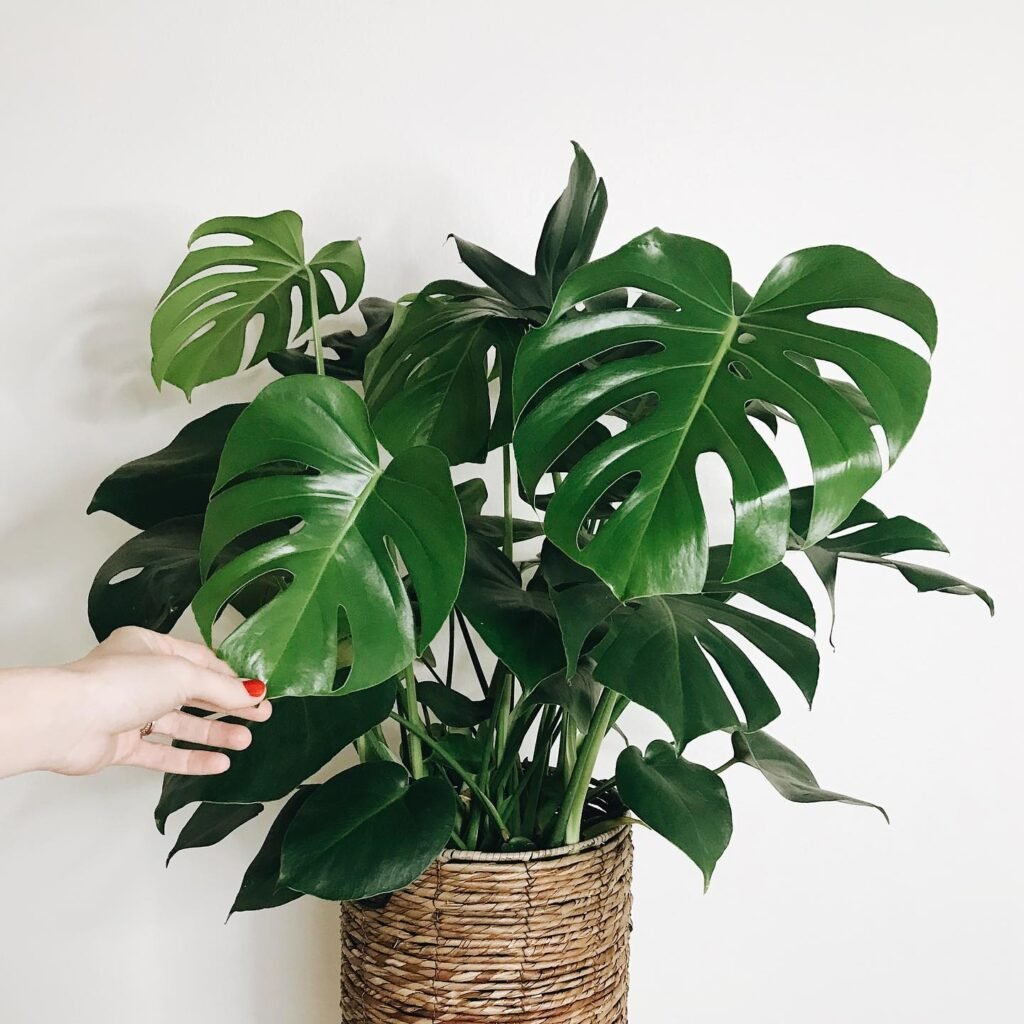
The Monstera Deliciosa, often called the Swiss Cheese Plant, is quite the showstopper with its big, green leaves that look like they’ve had holes punched in them. This plant is a native of the tropical rainforests in Central America, which explains its love for warm and humid conditions.
It’s got a few nicknames, thanks to its distinctive looks – apart from Swiss Cheese Plant, some folks call it the Hurricane Plant or the Mexican Breadfruit. Speaking of breadfruit, the Monstera Deliciosa isn’t just about good looks; it also produces fruit! The fruit looks a bit like a corn cob and tastes somewhat like a mix of banana, pineapple, and mango when ripe. But, for the fruit to mature and become edible, it needs quite specific conditions: plenty of warmth, high humidity, and time—often up to a year or more.
So, from its holey leaves to its tasty fruit, the Monstera Deliciosa brings a piece of the jungle right into your home. It’s a bit of a conversation starter, not just because of how it looks but also because of its delicious fruit, given the right conditions to flourish.
 Monstera Deliciosa plays a crucial role in its natural habitat, often serving as a support for other plants. In tropical forests, smaller plants may grow on its sturdy structure, benefiting from the Monstera’s height to reach sunlight. This relationship showcases nature’s interconnectedness and the Monstera’s role beyond its decorative value.
Monstera Deliciosa plays a crucial role in its natural habitat, often serving as a support for other plants. In tropical forests, smaller plants may grow on its sturdy structure, benefiting from the Monstera’s height to reach sunlight. This relationship showcases nature’s interconnectedness and the Monstera’s role beyond its decorative value.
What is The Difference Between Monstera Albo and Deliciosa?

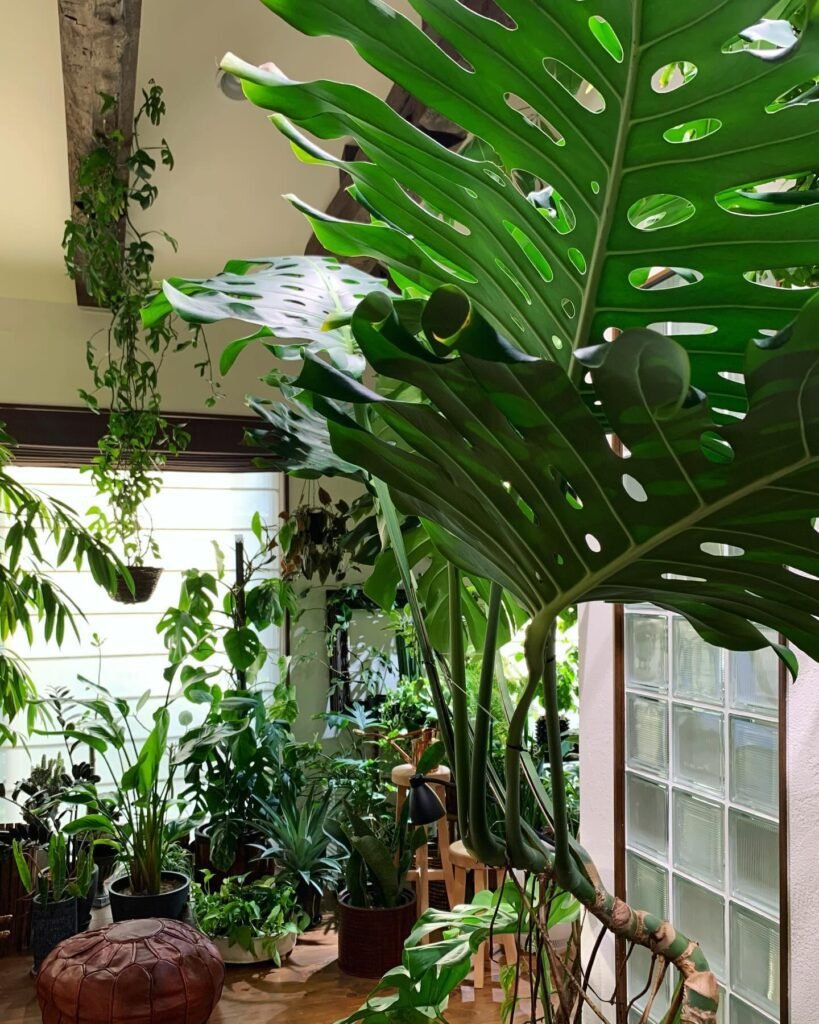
Monstera Albo and Monstera Deliciosa are two popular plants in the houseplant community, loved for their unique appearances. Here’s a quick comparison:
| Feature | Monstera Albo | Monstera Deliciosa |
|---|---|---|
| Leaf Colour | Variegated (white/cream and green) | Solid green |
| Price | Generally more expensive due to rarity | More affordable |
| Care Needs | Slightly more attention, especially to maintain variegation | Standard care for tropical plants |
Both the Monstera Albo and Deliciosa bring their own special charm to any space. The Albo’s variegated leaves add a striking visual contrast, while the Deliciosa offers lush, green vibrancy. Despite their differences, both plants share similar care needs, making them beloved by plant enthusiasts worldwide.
Light Requirements for Monstera Deliciosa


Monstera Deliciosa, also known as the Swiss Cheese Plant, really enjoys its light, but it’s a bit picky about it. Imagine it lounging in a spot where the sun gently filters through, much like in its natural rainforest home. Here’s how to get the lighting just right for this leafy friend:
- Loves Light: Aims for a bright spot without direct sunshine.
- No Harsh Sun: Direct sun can be too much, leading to sunburnt leaves.
- Avoid Dark Corners: Too little light, and it might not grow as well.
By finding a cosy, well-lit spot, your Monstera Deliciosa can thrive, showing off its beautiful green leaves. It’s all about mimicking that soft, dappled sunlight it loves so much.

Watering Tips for Monstera Deliciosa
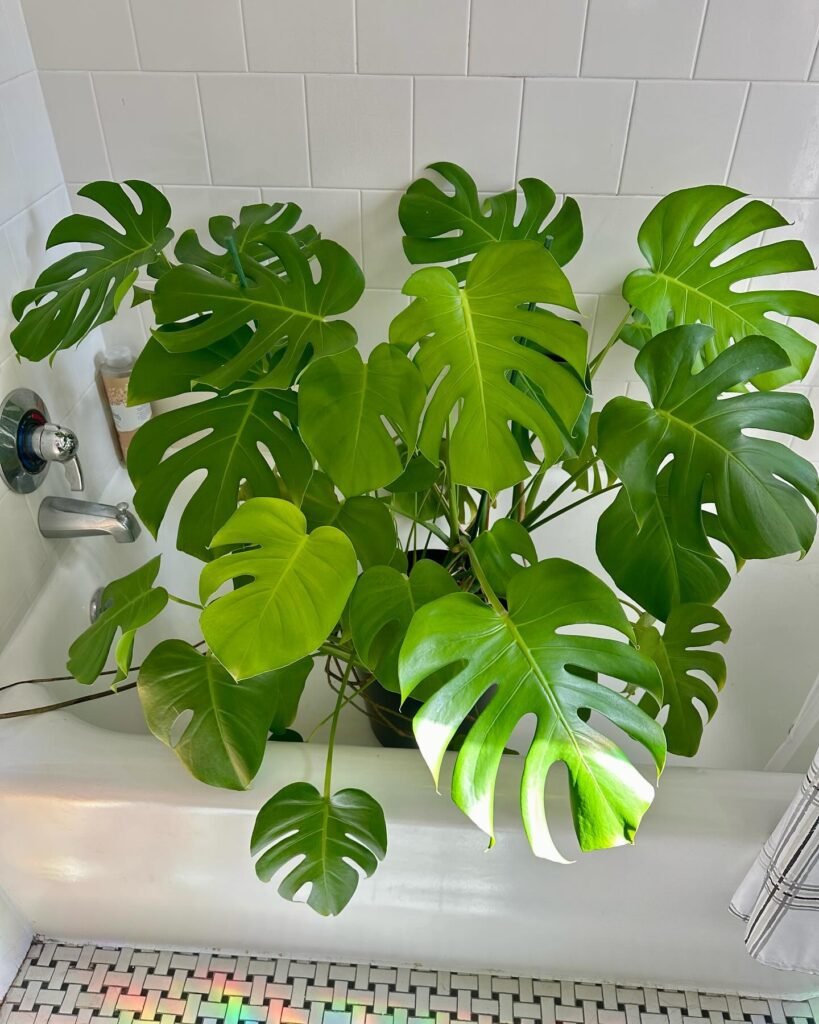

Keeping your Monstera Deliciosa perfectly watered is key to its health and happiness. Just like in its natural environment, it prefers a balance – not too wet and not too dry. Here’s how to nail the watering routine:
- Check the Soil: Wait until the top inch of soil is dry before giving it a drink.
- Deep Watering: When you water, do it thoroughly so the moisture reaches deep into the pot, then let any excess water drain away.
- Less in Winter: During the cooler months, your plant will use less water, so you can cut back a bit.
By following these watering tips, you’ll help your Monstera Deliciosa thrive. Just like with its light requirements, it’s all about finding that happy medium to keep your plant looking its best.

Fertilizing and Soil for Monstera Deliciosa

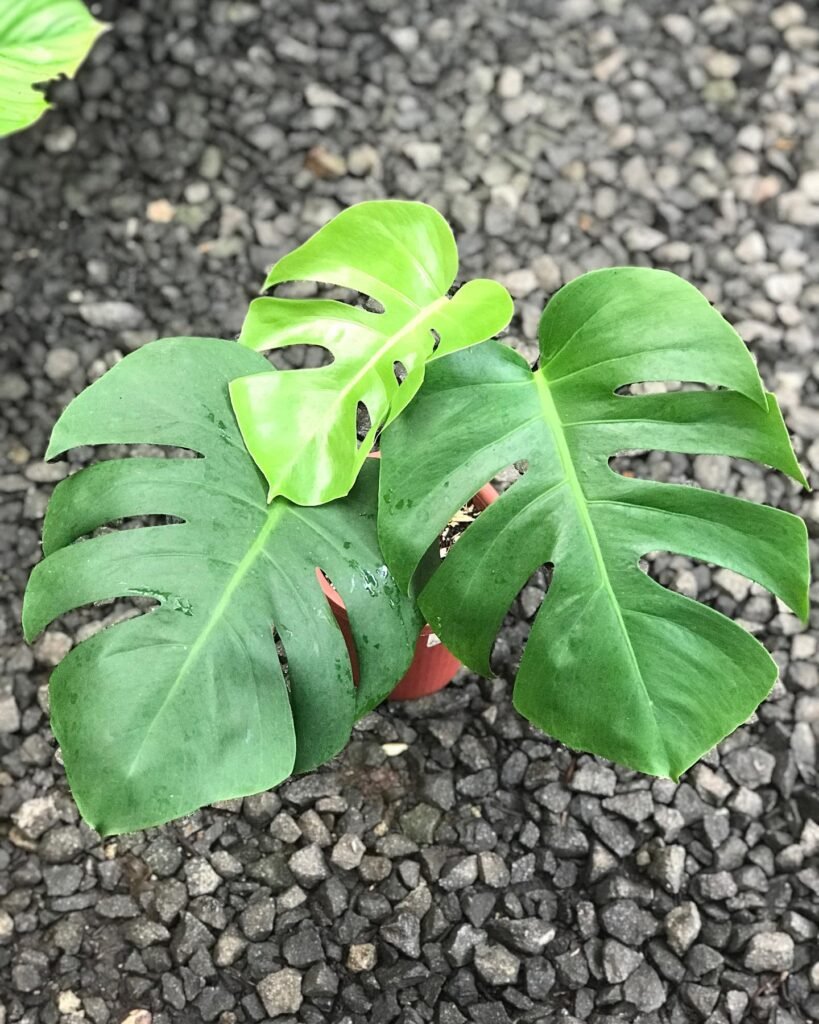
Feeding your Monstera Deliciosa and giving it the right soil is like laying down a red carpet for its roots. This plant isn’t too fussy, but it does have some preferences to keep it growing strong and healthy.
Here’s a simple guide:
| Aspect | Details |
|---|---|
| Soil Type | Use a well-draining, peat-based mix. Ideal for Monstera as it mimics their natural habitat by holding moisture without becoming waterlogged. |
| Fertilizer | Apply a balanced, water-soluble fertilizer once a month during the spring and summer months. This helps support growth without overwhelming the plant. |
This table aims to give you a clearer picture of what your Monstera Deliciosa needs in terms of soil and fertilizing. Just like a chef chooses the best ingredients for a recipe, picking the right soil and fertilizer will help your Monstera thrive, supporting its lush, green growth and ensuring it stays healthy and vibrant.

Pruning and Maintenance for Monstera Deliciosa

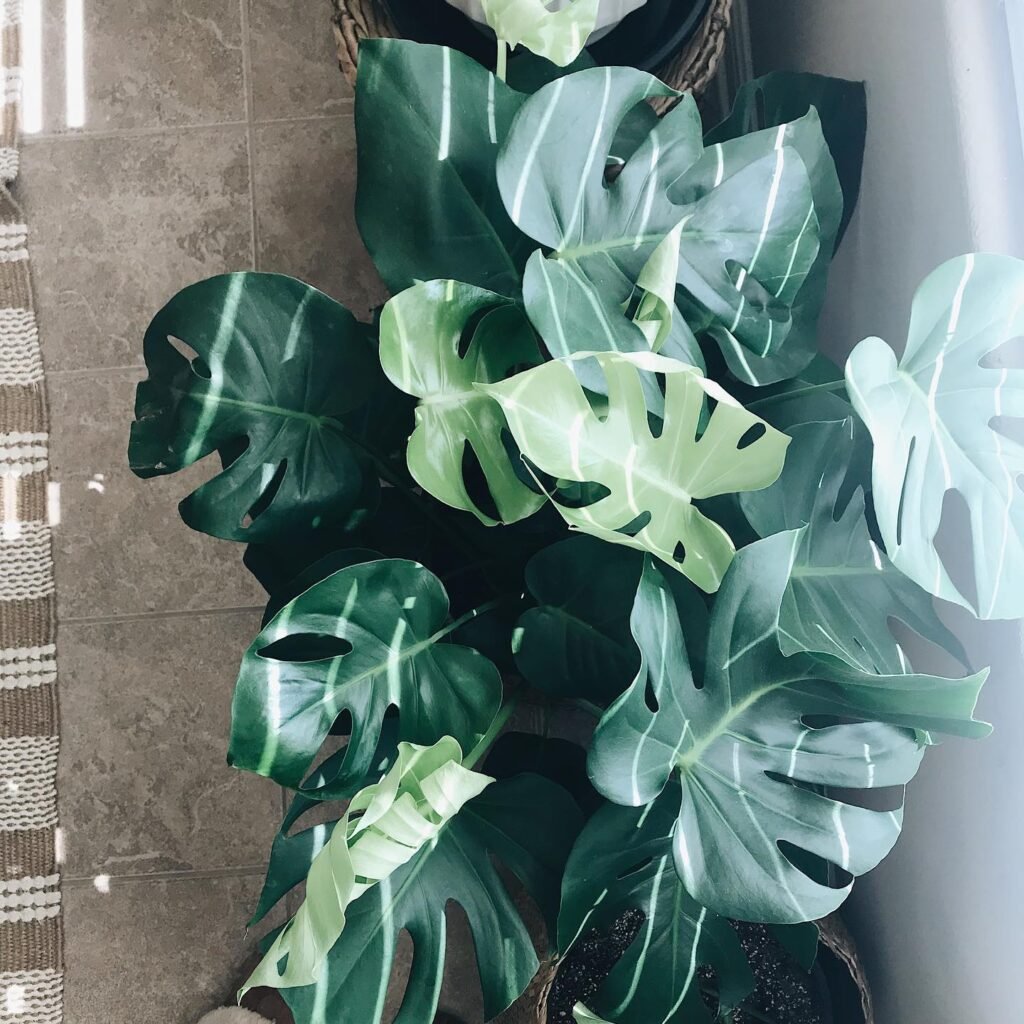
Looking after your Monstera Deliciosa isn’t just about watering and feeding; pruning and maintenance play a big part too. Keeping your plant well-groomed not only makes it look better but can also help it grow stronger and healthier. Here’s what you need to know:
- Trim Old Leaves: Cut off any yellow or damaged leaves to keep your plant looking fresh.
- Support Growth: Use stakes or a moss pole to support its climbing nature.
- Dust Off: Wipe the leaves gently with a damp cloth to keep them dust-free and shiny.
- Check for Pests: Keep an eye out for signs of pests and treat them early to prevent damage.
Regular pruning and maintenance ensure your Monstera Deliciosa stays in tip-top shape, allowing it to focus energy on new growth. Plus, a well-kept plant is a happy plant, and it’ll show its gratitude with beautiful, lush foliage.

Propagating Monstera Deliciosa (Swiss Cheese Plant)
Propagating Monstera Deliciosa is a fun and rewarding way to create new plants from your existing one. It’s not too tricky, and with a bit of patience, you can have baby Monsteras to keep or share with friends. Here’s the lowdown:
- Choose the Right Stem: Look for a healthy stem with at least one aerial root or node.
- Cutting: Use clean, sharp scissors or pruning shears to make your cut just below a node.
- Rooting Medium: You can root your cutting in water or directly into soil. Both methods work well, but water lets you see the roots grow!
- Care for Your Cutting: Place it in a spot with bright, indirect light and change the water weekly if using the water method. If in soil, keep the soil moist but not soggy.
By following these steps, you’ll see that propagating your Monstera Deliciosa is quite straightforward. It’s a lovely way to grow your indoor jungle or spread the plant love by gifting them to friends and family.

Repotting Tips for Monstera Deliciosa
Repotting your Monstera Deliciosa gives it more room to grow and fresh soil to thrive in. It’s a simple task that can make a big difference to your plant’s health.
Here’s what to do:
- When: If your Monstera’s roots are peeking out of the drainage holes or the growth has slowed, it’s time for a new pot.
- Choose a Pot: Pick one that’s a bit larger than the current one with good drainage.
- Soil: Use a fresh, well-draining potting mix suitable for tropical plants.
- Gentle Move: Carefully remove your Monstera from its old pot and tease out the roots gently if they’re compacted.
- Repot: Place it in the new pot, fill in with soil, and water it well.
Repotting doesn’t just give your Monstera Deliciosa space to grow; it’s a chance to check the roots for health and give it a new lease on life. A happy Monstera means more of those beautiful, Swiss cheese-like leaves to enjoy.
 Monstera Deliciosa, also known as the ‘Swiss Cheese Plant’, is famous for its large, heart-shaped leaves with unique natural holes. These holes help the plant withstand strong winds in its native tropical rainforests. The Monstera Deliciosa’s distinct appearance makes it a popular choice for plant lovers and interior decorators alike.
Monstera Deliciosa, also known as the ‘Swiss Cheese Plant’, is famous for its large, heart-shaped leaves with unique natural holes. These holes help the plant withstand strong winds in its native tropical rainforests. The Monstera Deliciosa’s distinct appearance makes it a popular choice for plant lovers and interior decorators alike.
Helpful Videos about Monstera Deliciosa (Swiss Cheese Plant)
Check out these cool videos we’ve picked on Monstera Deliciosa care. They’re packed with tips that’ll make looking after your plant a breeze. Perfect for anyone wanting to get their green thumb going!
- Monstera Deliciosa Plant Care: Beginner Swiss Cheese Plant Tips
Frequently Asked Questions about Monstera Deliciosa

Got questions about growing and caring for your Monstera Deliciosa? You’re in the right place! We’ve rounded up the most common questions to help you keep your Swiss Cheese Plant happy and thriving. From watering woes to leafy queries, we’ve got the answers.
It’s a tropical plant famous for its large, holey leaves, known as the Swiss Cheese Plant.
Water when the top inch of soil feels dry, usually once a week.
Yes, but indirect light. Direct sun can burn the leaves.
Prune it regularly to encourage new growth.
It survives in low light but thrives in bright, indirect sunlight.
Overwatering is a common cause. Let the soil dry out more between waterings.
Choose a pot 2 inches larger than the current one and repot using well-draining soil.
Yes, it can cause irritation if ingested by pets.
Cut a stem with at least one node and leaf, then root in water or soil.
Young plants or those not getting enough light may not develop fenestrations.
Use a humidifier or place it on a pebble tray with water.
A balanced, water-soluble fertilizer once a month during the growing season.
Check for over or under-watering and adjust accordingly.
In warm, tropical climates, yes. Otherwise, it’s best kept indoors.
Wipe them gently with a damp cloth to remove dust.
A peat-based, well-draining potting mix works well.
With proper care, it can grow quite quickly, adding several new leaves during the growing season.
We hope this FAQ sheds some light on looking after your Monstera Deliciosa. If your question wasn’t covered, don’t worry! Just pop it in the comments, and we’ll do our best to help you out. Remember, every plant parent starts somewhere, and there’s always more to learn in the journey of growing with your green friends.

